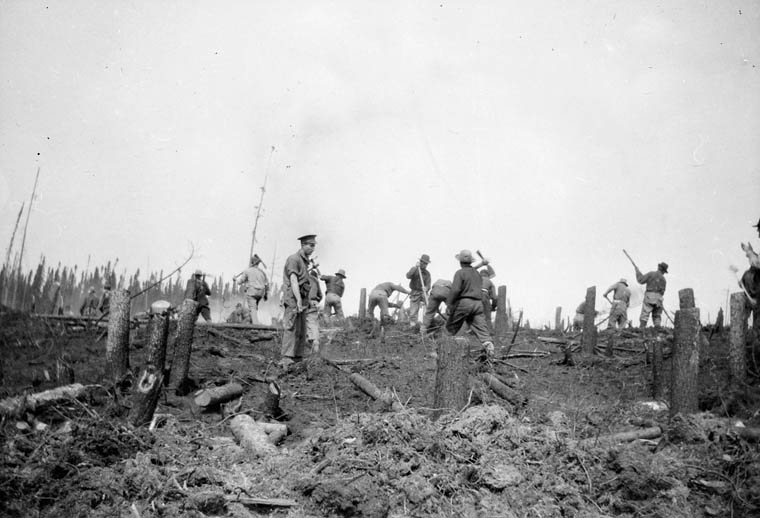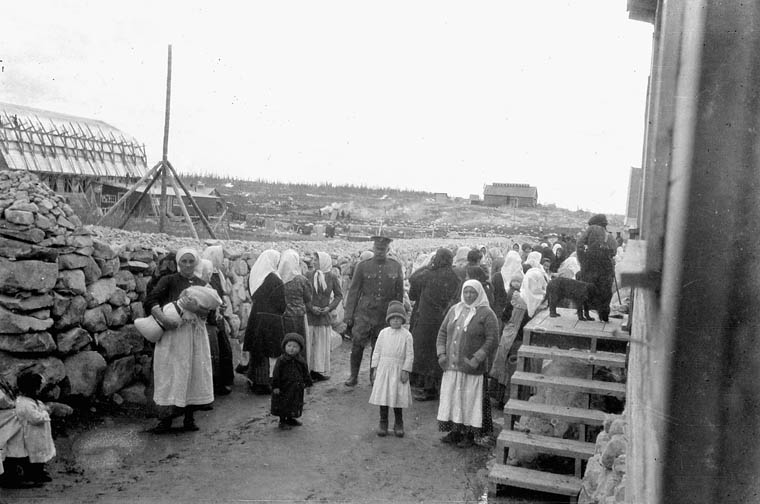Canada’s first national internment operations took place during the First World War, between 1914 and 1920. More than 8,500 men, along with some women and children, were interned by the Canadian government, which acted under the authority of the War Measures Act. Most internees were recent immigrants from the Austro-Hungarian, German and Ottoman empires, and mainly from the western Ukrainian regions of Galicia and Bukovyna. Some were Canadian-born or naturalized British subjects. They were held in 24 receiving stations and internment camps across the country — from Nanaimo, BC, to Halifax, Nova Scotia. Many were used as labour in the country’s frontier wilderness. Personal wealth and property were confiscated and much of it was never returned.

Discrimination and Prejudice
Internment operations were shaped by pre-war prejudices, which were made worse during wartime xenophobia. Between 1891 and the outbreak of the First World War, some 170,000 Ukrainian immigrants arrived in Canada, where they were promised free land. (See also Dominion Lands Act; History of Settlement in the Canadian Prairies; Ukrainian Settlement in the Canadian Prairies.)
Only a few years after these pioneer settlers arrived in the North-West Territories, a clergyman, Father Moris, expressed his loathing for them in Calgary’s Daily Herald on 27 January 1899. (Note that in the quote Galicians refers to people from Galicia, a region in Eastern Europe with a large Ukrainian population.)
As for the Galicians I have not met a single person in the whole of the North West who is sympathetic to them. They are, from the point of view of civilization, 10 times lower than the Indians. They have not the least idea of sanitation. In their personal habits and acts [they] resemble animals, and even in the streets of Edmonton, when they come to market, men, women, and children, would, if unchecked, turn the place into a common sewer.
Such bigotry persisted in the immediate post-war period. An inflammatory editorial in the 10 February 1919 Winnipeg Telegram demanding “Enemy Aliens Must Go” questioned whether it was necessary to “import a race of inferior beings to do our work” or right for returning soldiers “to compete with the bohunks of Central Europe, who have been accustomed in their own country to submit to being driven like cattle, who are ignorant of every principle of sanitation, and lost to all sense of decency in living conditions.”

War Measures Act and Wartime Elections Act
During the First World War, the Government of Canada imprisoned thousands of people under the authority of the War Measures Act. (See also Internment in Canada.) Parliament adopted the Act on 22 August 1914. It gave Cabinet sweeping powers to suspend civil liberties and govern by order-in-council. This meant it could make and impose laws without approval from the House of Commons or the Senate. Approximately 80,000 people, mostly Ukrainian, had to register as “enemy aliens” and were compelled to report regularly to the police. The government also restricted their freedom of speech, movement and association.
The passage of the Wartime Elections Act in September 1917 took away the vote from those who came to Canada after March 1902. (See Right to Vote.) This undercut their ability to protest their mistreatment by voting against the government. (See also Union Government.)

Labour Camps
Internees were forced to work in the national parks of Western Canada. They were used to build roads, clear bush and cut trails. They even built a portion of the golf course at Banff National Park. Others helped carve experimental farms out of the boreal wilderness near Kapuskasing, Ontario, and Spirit Lake, Quebec.
Conditions were trying and the guards were sometimes brutal. Resentment at what many regarded as their unjust confinement was widespread. This provoked resistance, some of which was passive, such as work slowdowns. Other efforts were more determined. There were escape attempts and even a riot involving 1,200 internees at Kapuskasing in May 1916. Three hundred armed soldiers were needed to put it down.
In total, 107 internees died in captivity. Six were shot dead while trying to escape. Others died from infectious diseases, work-related injuries and suicide. In many cases, they were buried in unmarked graves or cemeteries far from their communities and loved ones.

Parole
Due to the war effort and the number of soldiers overseas, able-bodied men were needed on various labour projects and on farms across Canada. In 1916–17, many internees were paroled to perform these duties. They were paid a wage that was confiscated by the authorities, to whom they were required to report. However, the revolution in Russia and the Bolshevik coup d’état in October 1917 led to a Red Scare and more arrests. Many men were confined again, sometimes in prisons such as the Kingston Penitentiary.

Deportation
After the war, expulsions of “radical aliens” were common. Some 1,000 men were deported from the Kapuskasing internment camp alone. Even after the armistice on 11 November 1918, the Internment Operations Branch, commanded by Sir William Otter, remained active until June 1920. When internment was no longer necessary, many in the government saw deportation as the next logical step. Hugh Macdonald, Sir John A. Macdonald’s son, shared this intolerance. As a magistrate, he wrote to Arthur Meighen, acting minister of justice, on 3 July 1919. He referred to the Ruthenians, Russians, Poles and Jews in Manitoba as “a very bad and dangerous element.” He advocated using “fear” to make “the foreign element here… as gentle and easily controlled as a lot of sheep.”
However, these views were not unanimous. Some Canadian statesmen thought these were unjust measures. Sir Wilfrid Laurier, for example, criticized the Wartime Elections Act in 1917. In the House of Commons on 10 September, he said:
If it be said in Canada that the pledges which we have given to immigrants when inviting them to come to this country to settle with us, can be broken with impunity, that we will not trust these men, and that we will not be true to the promise which we made to them, then I despair of the future of this country.
Did you know?
Many Ukrainians enlisted voluntarily in the Canadian Expeditionary Force. The most famous was Corporal Filip Konowal. His valour at the Battle for Hill 70 in August 1917 was recognized with a Victoria Cross. Ukrainian Canadians fought alongside thousands of “Austrian” Ukrainians, who misrepresented who they were to enlist.
Official Records and Personal Accounts
Few internees left personal accounts of what happened. Many were too ashamed or afraid to recount their experiences, even to family members or friends. Most of the official internment operation records were deliberately destroyed decades later. This further erased the episode in Canadian history, though not every trace.
Nick Olynyk, prisoner #98 at the Castle Mountain camp in Banff, wrote to his wife:
As you know yourself there are men running away from here everyday because the conditions here are very poor… We are as hungry as dogs. They are sending us to work, as they don’t believe us, and we are very weak.
The father of nine-year-old Katie Domytryk was arrested in Edmonton in March 1916. He was interned in the Lethbridge camp, then moved over 2,500 km east to the Spirit Lake camp in Quebec. His daughter wrote to him:
We haven’t nothing to eat and they do not want to give us no wood. My mother has to go four times to get something to eat.… This shack is no good, my mother is going down town every day and I have to go with her and I don’t go to school at winter.
A letter published in Calgary’s Daily Herald on 29 February 1917 was signed by 12 women. It read:
We, the undersigned, Ukrainian and Austrian women, wish to bring before the notice of the women of Calgary [that] we came to this country to make Canada our future home. We are not spies. Thousands of our men are fighting under the British and Russian flags. We have been discharged from work because we are considered aliens but we are loyal to Canada. What are we to do if we cannot get work?… Will not the women of Calgary speak for us?

Campaign for Recognition and Symbolic Redress
Efforts to gain redress (acknowledgement and compensation) for Canada’s first national internment operations began in 1978. Internee Nick Sakaliuk gave testimony to historians about his experiences as an internee at Fort Henry in Kingston and then in the Petawawa and Kapuskasing camps. Almost a decade passed before a redress campaign began. The Ukrainian Canadian Civil Liberties Association (UCCLA) led the campaign. It followed the lead of another survivor, Montreal-born Mary Manko Haskett. She believed that any redress campaign should be “about memory, not money.” Haskett was six years old when she was exiled to the Spirit Lake camp. Her younger sister Nellie died there.
In January 1992, accounting firm Price Waterhouse produced a report. It estimated that the losses suffered by victims of Canada’s First World War internment operations could be valued between $21.6 and $32.5 million (1991 dollars). However, survivors never requested an official apology, nor did they seek compensation to individual survivors or their descendants. Haskett believed that contemporary society should not bear direct responsibility for what happened decades earlier.
The UCCLA made concerted efforts to raise public awareness through initiatives such as the installation of historical markers and statues. A trilingual plaque was unveiled by a Spirit Lake camp survivor, Stefa Mielniczuk, at Fort Henry on 4 August 1994.
Ukrainian Canadian Restitution Act
Conservative MP Inky Mark, whose family had endured the Chinese head tax, advanced the redress effort. In 2004, Mark submitted private member’s Bill C-331 “to recognize the injustice that was done to persons of Ukrainian descent and other Europeans who were interned at the time of the First World War.” It called for the federal government “to provide for public commemoration and for restitution which is to be devoted to education and the promotion of tolerance.” The Ukrainian Canadian Restitution Act became law on 25 November 2005.
The Endowment Council of the Canadian First World War Internment Recognition Fund (CFWWIRF) was established in 2008. It manages commemorative and educational projects and represents all communities affected by the internment operations. Symbolically, the settlement was signed in Toronto’s Stanley Barracks, a “receiving station” for internees from 14 December 1914 to 2 October 1916.
Legacy and Significance
During the First World War, thousands of Eastern Europeans found themselves targeted for internment and other repressive measures because of where they had come from. The crippling legacy of what happened to them endured for decades. Reflecting on how the civil liberties of so many Canadians were denied on two subsequent occasions — during the Second World War and the 1970 October Crisis — a survivor, Mary Manko Haskett, said: “What was done to us was wrong. Because no one bothered to remember or learn about the wrong that was done to us it was done to others again, and yet again. Maybe there’s an even greater wrong in that.”

 Share on Facebook
Share on Facebook Share on X
Share on X Share by Email
Share by Email Share on Google Classroom
Share on Google Classroom







